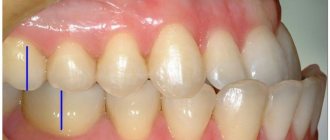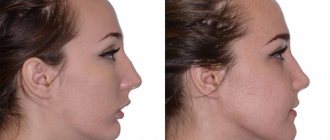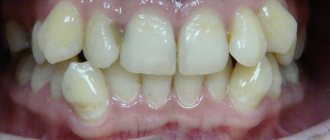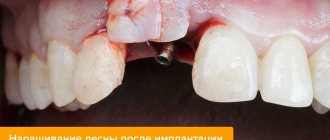- Surgical department
Surgical department » - Maxillofacial Surgery
Maxillofacial Surgery "
- Jaw osteotomy
Malocclusion is a violation of the process of chewing food and swallowing it, a negative effect on the speech apparatus, as well as an aesthetic defect. With malocclusions, the upper and lower jaws can be enlarged or reduced in size, pushed forward or positioned posterior to the normal position, shifted to the side or tilted, turning clockwise or counterclockwise. In this case, the closure of the teeth is disrupted to one degree or another, they change the angle of inclination, turn around, run into each other (crowding) or diverge with the formation of cracks (treme).
What are the dangers of malocclusion?
- Violation of dental contacts makes it difficult to chew food and provokes the development of diseases of the gastrointestinal tract.
- Severe malocclusions so limit the possibilities of normal nutrition that they are a reason for deferment from the army.
- Changing the angles of inclination of the teeth affects the distribution of the load during chewing, leads to overload of the periodontium, the development of gum inflammation and, ultimately, earlier tooth loss.
- Teeth crowding, combined with misalignment, affects the natural cleaning of teeth, further leading to the development of gum disease and an increased likelihood of tooth enamel destruction. If tooth loss has already occurred, then violations of the jaw relationships can create difficulties in prosthetics.
- Malocclusion leads to a change in the trajectory of jaw movement during chewing: the temporomandibular joints are overloaded, and dysfunction of the temporomandibular joints develops.
- Some types of malocclusion are anatomical prerequisites for narrowing the airways, for the appearance of snoring and such a serious condition as sleep apnea.
Results of orthognathic surgery
Orthognathic surgery transforms a person, giving him the opportunity to look more beautiful, younger, and do what he loves without being embarrassed by his own appearance. A symmetrical face shape is not only beautiful: maxillofacial anomalies are accompanied by disruption of many body systems, leading to deterioration in breathing, chewing food and diseases of the gastrointestinal tract.
With the help of surgical treatment, it is possible to change the length of the jaw, its position and shape, and improve the condition of the chin. As a result of timely correction, the appearance is transformed, facial features become symmetrical and the overall health of a person improves.
Due to the fact that the surgeon makes all the incisions from the inside, the integrity of the external tissues and the beauty of the facial skin are preserved. Surgical treatment is not accompanied by the appearance of scars and other residual effects. The patient receives maximum aesthetic results and gets rid of malocclusions, which often lead to speech and chewing disorders.
If you suffer from severe malocclusions that cannot be completely corrected with braces or other orthodontic options, you can schedule a consultation with our Clinic's oral and maxillofacial surgeon online or via Skype.
The specialists of the CONSTANTA Clinic in Yaroslavl have many years of experience in the field of plastic and aesthetic surgery. They have at their disposal modern methods of bite correction and safe methods of surgical intervention. Surgeons are focused on the interests of patients and the safest and most effective elimination of anomalies and defects in the structure of the dental system.
Preparing for surgery
Consultation with a plastic surgeon
Before the start of the preparatory period and a comprehensive examination, the doctor must conduct a conversation with the patient in order to warn him about possible risks and contraindications, develop an individual occlusion correction scheme and a surgical intervention plan. The specialist must exclude the presence of diseases that can cause complications both during the operation and in the postoperative period.
Laboratory tests and choice of anesthesia
Before the operation, the patient undergoes a comprehensive examination, which includes laboratory tests. Diagnostic data is carefully studied by the operating surgeon and anesthesiologist, who plan consultations and choose the optimal type of surgery and anesthesia option.
Comfortable postoperative period
From the first minute you contact our specialists, qualified employees who are interested in the successful outcome of the operation will work with you. The rooms are equipped with functional beds and have everything necessary for a comfortable stay. At any time you can call the Clinic’s specialists, get answers to your questions or receive qualified medical assistance.
Personal manager for operation planning
Each patient can use the free Personal Manager service. To do this, you need to call the phone number (4852) 37-00-85 or inform us of your desire to use the service by writing to For out-of-town patients, we offer correspondence consultation via Skype or e-mail.
Jaw osteotomy surgery
Historically, the first operations were performed on the lower jaw. And the surgeon’s task was precisely to restore normal jaw relationships. But today operations on the lower jaw alone account for no more than 10% of operations performed. Because the surgeon’s tasks have changed: now it is not only the correction of the bite, but also the improvement of facial aesthetics.
Double-jaw osteotomy is an operation on the lower and upper jaw simultaneously, which allows you to achieve aesthetically favorable proportions of the face both in front and in profile, eliminate asymmetry, and make the smile brighter by eliminating dark corridors - shading of the lateral teeth of the upper jaw. We can say that surgery on one jaw is only a correction of functionality, on two – functionality and aesthetics.
Indications for the operation:
- violation of the closure of the dentition, which cannot be corrected orthodontically;
- pronounced facial disproportions that have aesthetic significance.
Contraindications:
- unpreparedness of the dentition for surgery (insufficient orthopedic or orthodontic preparation);
- diseases of internal organs that prevent surgery or anesthesia.
Medicines during the rehabilitation period
After the operation, you will receive a set of medications to take home and instructions for their use. Taking medications can reduce the risk of infection and relieve unpleasant symptoms.
Patients are prescribed:
- Antibacterial agents Most often, combination drugs are used that cope well with infections of the oral cavity and upper respiratory tract. A standard seven-day course is prescribed, which minimizes the risk of an inflammatory process. During this period, you should not drink alcoholic beverages or take medications that suppress the immune system, such as hormonal drugs (prednisolone).
- Antihistamines Help relieve swelling, which is pronounced in the first days after bone grafting and can cause serious inconvenience to the patient. As a rule, tablet forms of the drug are used.
- Antiseptic solution In most cases, Chlorhexidine is used. It is used to treat the oral cavity, but not to rinse. Helps fight pathogenic microorganisms in the wound surface area.
- Analgesics Painkillers that help eliminate severe pain during the first days after bone grafting. The drugs should be taken as prescribed by a doctor, most often one tablet with a break between doses of at least 4 hours.
- Healing ointment Topical application accelerates tissue regeneration. Used for rapid healing of the wound area.
An individual set is compiled for each patient , depending on the type and volume of the operation. Self-administration of medications is strictly prohibited; it can significantly increase the risk of complications or harm the body as a whole.
Read more here - Medications after surgery
Stages of treatment
Today, the method of combined treatment of malocclusions, when the orthodontist begins work first, is considered generally accepted in the world.
1) Orthodontic stage
The orthodontist places braces on both jaws and begins to move the teeth so that they take the correct position in relation to the jaws. In this case, a temporary deterioration in the closure of teeth occurs. It takes about nine months to prepare. After this, the surgical stage is performed.
2) Surgical stage
The operation is performed under general anesthesia. The intervention is performed via intraoral access, which allows it to avoid leaving scars. In accordance with the treatment plan, cuts are made on the upper and lower jaws, the fragments are mobilized and installed in the most functionally and aesthetically advantageous position. Next, the jaws are fixed with titanium miniplates, which are invisible to the body, do not ring at the airport and do not interfere with MRI. They usually remain in the body for life without causing any consequences. In rare cases, surgery may be performed before orthodontic treatment begins.
Oral care after bone grafting
Proper oral hygiene is important to prevent complications. Caring for your teeth and the operated area should be thorough and gentle.
- Brushing your teeth is recommended after every meal for several days after surgery.
- Use only a soft toothbrush
- During cleansing, do not touch the operated area.
- Active rinsing of the mouth with antiseptics is prohibited; oral baths are allowed
- Treatment of operated areas is carried out with moistened cotton swabs
- The wound surface and sutures should be treated extremely carefully to avoid mechanical damage.
Cleaning the mouth after eating should be thorough but gentle. In the first days after surgery, it is quite easy to cause bleeding or suture dehiscence.
Read more about the rules of care - Oral care
General recommendations after bone grafting
Following your doctor's recommendations during the rehabilitation period will prevent possible complications. The list is in the medicine package.
General recommendations after bone grafting:
- At first, it is better to refrain from chewing on the operated side.
- For the first 2-3 days it is recommended to eat only crushed food at room temperature
- You should not smoke or drink alcohol for 2 weeks after surgery.
- Do not drink through a straw
- It is recommended to cough gently and with your mouth open so as not to increase the pressure in the mouth.
- Sleep better with the head of the bed raised
- Serious physical activity and diving for several weeks are prohibited
- Prolonged exposure to the sun is not recommended; you should avoid visiting solariums.
- It is prohibited to visit the sauna or bathhouse
- You should avoid flying in the first few weeks after bone grafting.
The patient must maintain physical and emotional rest. The doctor will monitor your condition and monitor you during scheduled visits.
When should you see a doctor outside of your plan?
Postoperative symptoms are most often an explainable physiological reaction. However, under certain circumstances they can turn into signs of dangerous complications. The patient must be able to distinguish pathology from normality.
Among the complications that arise during the rehabilitation period, the first place always remains infection of the wound site and internal structures, for example, the maxillary sinus after sinus lifting. In this situation, the patient notes:
- severe pain;
- worsening swelling;
- redness of the gums;
- the appearance of purulent discharge;
- temperature increase.
Contact a doctor should be immediate . The surgeon treats the oral cavity, sometimes it is necessary to remove sutures and clean the area with bone material. A course of antibiotics and anti-inflammatory drugs will be prescribed.
There is another unpleasant complication - suture dehiscence. In such a situation, you should immediately go to the clinic, where the dentist will apply new surgical sutures. As a rule, no additional action is required, but in rare cases the graft may become dislodged, which requires almost a second surgical intervention.
Complications associated with rejection of the osteoplastic material or poor fixation of the implants require another bone grafting. Such adverse outcomes may be associated with improper implementation of the dentist's recommendations, so it is important to strictly follow them.
Read more here - Complications after sinus lift and bone grafting











